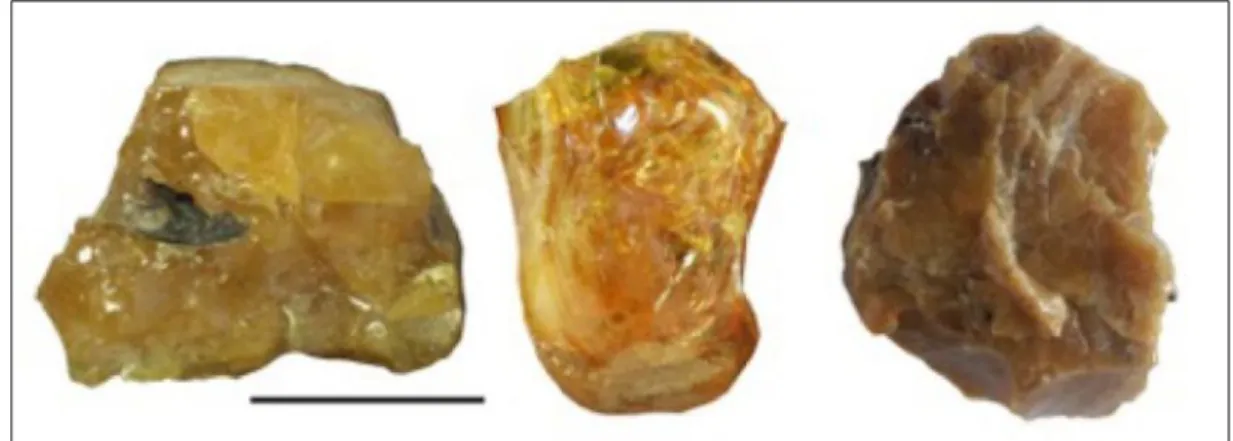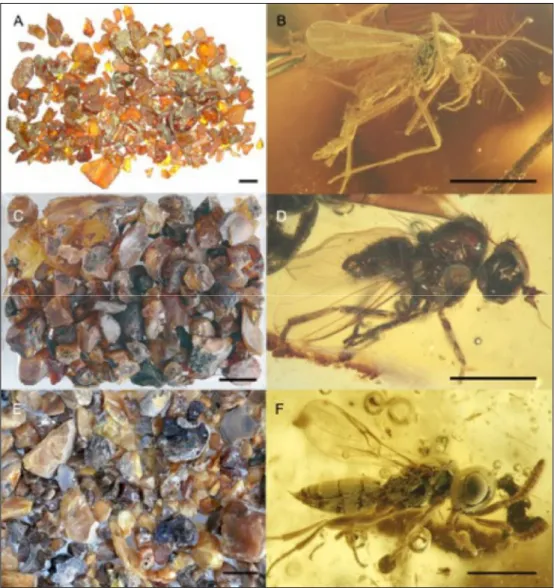HAL Id: insu-01743297
https://hal-insu.archives-ouvertes.fr/insu-01743297
Submitted on 26 Mar 2018HAL is a multi-disciplinary open access archive for the deposit and dissemination of sci-entific research documents, whether they are pub-lished or not. The documents may come from teaching and research institutions in France or abroad, or from public or private research centers.
L’archive ouverte pluridisciplinaire HAL, est destinée au dépôt et à la diffusion de documents scientifiques de niveau recherche, publiés ou non, émanant des établissements d’enseignement et de recherche français ou étrangers, des laboratoires publics ou privés.
From Cretaceous to Eocene: an overview of the
fossiliferous amber deposits from France
Vincent Perrichot
To cite this version:
Vincent Perrichot. From Cretaceous to Eocene: an overview of the fossiliferous amber deposits from France. Amberif 2018, Mar 2018, Gdansk, Poland. �insu-01743297�
Amberif 2018 INTERNATIONAL SYMPOSIUM “AMBER. SCIENCE AND ART” Page 7
LIFE TRACES IN AMBER
ORAL PRESENTATIONSPERRICHOTV.
From Cretaceous to Eocene: an overview
of the fossiliferous amber deposits from France
KEYNOTE lecture
VINCENTPERRICHOTGéosciences, Université de Rennes, Campus de Beaulieu bat. 15, 263 avenue du Général Leclerc, 35000 Rennes, France, vincent.perrichot@univ-rennes1.fr
The presence of amber in France was mentioned as early as in the beginning of the 18th century
(Anonymous 1705), and by the early 20thcentury amber was reported from nearly 70 French localities of
Carboniferous to Miocene age (Lacroix 1910). Despite these early reports, the French fossil resins remained largely ignored by paleontologists, and it is only in the 1970s that fossil biological inclusions were first documented, with approximately 70 arthropods described from two Cenomanian deposits of the Paris Basin (Schlüter 1975, 1978, 1983). However, these arthropods were found in a turbid, barely translucent amber (Figure 1), making investigation for fossil inclusions excessively difficult (Schlüter and Stürmer 1982). This and the fact that Lacroix (1910) depicted all French fossil resins as brittle retinites, inapt to sizing and polishing, probably explain that no further work was done on French amber until more recently.
Fig. 1. Typical aspect and colours of the Cretaceous (Cenomanian) amber of the Paris Basin. Scale bar: 0.5 mm.
Two amber-rich, highly fossiliferous deposits were then discovered simultaneously in the late 1990s: the early Eocene (Sparnacian) Oise amber in the Paris Basin (Figure 2A-B), from which more than 20.000 arthropod inclusions have been reported to date (Nel et al. 1999; Nel and Brasero 2010); and the mid-Cretaceous (Albian-Cenomanian) Charentese amber in the Aquitain Basin (Figure 2E-F), that has yielded more than 2.000 arthropods (Néraudeau et al. 2002; Perrichot et al. 2010). Following these discoveries, extensive field investigations have revealed fossiliferous amber in several other historical or new outcrops across France, all restricted to the Cretaceous period. Although less abundant and diverse than in Oise and Charentese ambers, arthropods have been found in a Cenomanian amber from two localities in the Alps (SE France) and the Pyrenees (SW France) (Perrichot et al. 2006; Girard et al. 2013); a small but highly fossiliferous deposit has been found in the Turonian of Vendée (NW France; Figure 2C-D) (Néraudeau et al. 2017); and few arthropods have also been found in the Santonian amber of Provence (SE France) (Choufani et al. 2013; Nel et al. 2017).
The chemical analysis of these ambers from various localities and ages indicates a succession of different plant sources through time (Nohra et al. 2015). All Cretaceous resins originated from conifers, more
Cupressaceae during the Turonian and Santonian. The Eocene Oise amber was produced by an angiosperm of the family Fabaceae, differing markedly from the slightly younger Baltic amber that has a coniferous origin.
Fig. 2. Representative amber samples and insect inclusions from France. A-B. Eocene amber of Oise; B. a non-biting midge (Diptera: Chironomidae).C-D. Turonian amber of Vendée; D. Microphorites magaliae Perrichot et Engel, 2014 (Diptera: Dolichopodidae). E-F. Albian-Cenomanian amber of Charentes; F. a scelionid wasp (Hymenoptera). Scale bars: 0.5 mm.
Both Oise and Charentese ambers constitute major world deposits in terms of abundance and diversity of inclusions, providing a rare glimpse into two ancient forest ecosystems of Western Europe. Oise amber was produced by legume trees growing in a semi-deciduous forest in a lacustrine to palustrine environment of a deltaic region (Nel and Brasero 2010). Charentese amber originated from conifers growing in a marginal marine setting, likely a mosaic of estuarine and mangrove environments (Perrichot et al. 2010).
References
Anonymous. 1705. Mémoire sur l’ambre jaune. Hist. Acad. R. Sci. (Paris), 41-44.
Choufani J., Perrichot V., Girard V., Garrouste R., Azar D., Nel A. 2013. Two new biting midges of the modern type from Santonian amber of France (Diptera: Ceratopogonidae), in: Azar D., Engel M.S, Jarzembowski E., Krogmann L., Nel A., Santiago-Blay J. (Eds.) Insect Evolution in an amberiferous and stone alphabet. Proceedings of the 6th
International Congress on Fossil Insects, Arthropods and Amber. Brill, Leiden, The Netherlands, 71-95. Girard V., Breton G., Perrichot V., Bilotte M., Le Loeuff J., Nel A., Philippe M., Thévenard F. 2013. The Cenomanian
amber of Fourtou (Aude, Southern France): Taphonomy and palaeoecological implications. Ann. Paléontol. 99, 301-315.
Lacroix A. 1910. Groupe des résines fossiles. Minéral. Fr. 4, 637-645.
Nel A., Brasero N. 2010. Oise amber, in: Penney D. (Ed.) Biodiversity of fossils in amber from the major world deposits. Siri Scientific Press, Manchester, 137-148.
Amberif 2018 INTERNATIONAL SYMPOSIUM “AMBER. SCIENCE AND ART” Page 9
Nel A., De Ploëg G., Dejax J., Dutheil D., De Franceschi D., Gheerbrant E., Godinot M., Hervet S., Menier J.J., Augé M., Bignot G., Cavagnetto C., Duffaud S., Gaudant J., Hua S., Jossang A., De Lapparent F., Pozzi J.P., Paicheler J.C. Rage J.-C. 1999. Un gisement sparnacien exceptionnel à plantes, arthropodes et vertébrés (Eocène basal, MP7): Le Quesnoy (Oise, France). C. R. Acad. Sci. (IIa) 329, 65-72.
Nel A., Garrouste R., Daugeron C. 2017. Two new long-legged flies in the Santonian amber of France (Diptera: Dolichopodidae). Cret. Res. 69, 1-5.
Néraudeau D., Perrichot V., Dejax J., Masure E., Nel A., Philippe M., Moreau P., Guillocheau F., Guyot T. 2002. Un nouveau gisement à ambre insectifère et à végétaux (Albien terminal probable): Archingeay (Charente-Maritime, France). Geobios 35, 233-240.
Néraudeau D., Perrichot V., Batten D.J, Boura A., Girard V., Jeanneau L., Nohra Y.A., Polette F., Saint Martin S., Saint Martin J.P., Thomas R. 2017. Upper Cretaceous amber from Vendée, north-western France: age dating and geological, chemical, and palaeontological characteristics. Cret. Res. 70, 77-95.
Nohra Y.A., Perrichot V., Jeanneau L., Le Pollès L., Azar D. 2015. Chemical characterization and botanical origin of French ambers. J. Nat. Prod. 78, 1284-1293.
Perrichot V, Nel A, Guilbert E, Néraudeau D. 2006. Fossil Tingoidea (Heteroptera: Cimicomorpha) from French Cretaceous amber, including Tingidae and a new family, Ebboidae. Zootaxa, 1203, 57-68.
Perrichot V., Néraudeau D., Tafforeau P. 2010. Charentese amber, in: Penney D. (Ed.) Biodiversity of fossils in amber from the major world deposits. Siri Scientific Press, Manchester, 192-207.
Schlüter T. 1975. Nachweis verschiedener Insecta-Ordines in einem mittelkretazischem Harz Nordwestfrankreichs. Entomol. Ger. 1, 151-161.
Schlüter T. 1978. Zur Systematik und Palökologie harzkonservierter Arthropoda einer Taphozönose aus dem Cenomanium von NW-Frankreich. Berliner Geowiss. Abh. (A) 9, 1-150.
Schlüter T. 1983. A fossiliferous resin from the Cenomanian of the Paris and Aquitanian Basin of Northwestern France. Cret. Res. 4, 265-269.
Schlüter T., Stürmer W. 1982. X-ray examination of fossil insects in Cretaceous amber of N.W. France. Ann. Soc. Entomol. Fr. 18, 527-529.
SONTAGE., SZWEDOJ., SZADZIEWSKIR.
20 years of the Museum of Amber Inclusions
at the University of Gdańsk
ELŻBIETASONTAG, JACEKSZWEDO, RYSZARDSZADZIEWSKI
Laboratory of Evolutionary Entomology and Museum of Amber Inclusions, Department of Invertebrate Zoology and Parasitology, University of Gdańsk, 59, Wita Stwosza St., PL80-308 Gdańsk, Poland,
elzbieta.sontag@biol.ug.edu.pl, jacek.szwedo@biol.ug.edu.pl, ryszard.szadziewski@biol.ug.edu.pl
Twenty years ago, on 29 May 1998, the Senate of the University of Gdańsk decided to establish the Museum of Amber Inclusions at the Department of Invertebrate Zoology, Faculty of Biology. On a single day, a dream came true for two organisations: the Fossil Insects Section (currently the Palaeoentomological Section of the Polish Entomological Society) and the International Amber Association. And so, owing to the joint efforts of researchers and the Gdańsk-based amber community, the pre-WWII tradition of collecting natural amber artefacts returned to Gdańsk, while a scientific centre focused on gathering and studying inclusions preserved in fossil resins began to develop here. The idea to create a collection of inclusions and raw amber at the University of Gdańsk was successfully implemented owing to the kind support of the UG Rector Prof. Marcin Pliński, the Faculty's Dean Prof. Halina Piekarek-Jankowska, the Chairman of the Fossil Insects Section Prof. Jan Koteja and the Gdańsk-based amber artist Wiesław Gierłowski.
The collaboration between Gdańsk scientists and the amber industry began in the early 1980s when the then doctor, today Prof. Ryszard Szadziewski of the University of Gdańsk, together with the then doctor and currently Prof. Wiesław Krzemiński (Institute of Systematics and Evolution of Animals, Polish Academy of Sciences, Kraków) extended their research on contemporary dipterans to include fossil species preserved in Baltic amber, based on the collection of the PAS Museum of the Earth, Warsaw. In 1985, the Fossil Insects
View publication stats View publication stats

